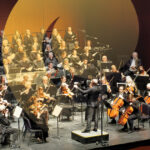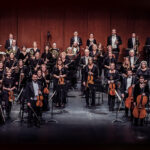Program Notes, ©2013 Lori Newman
Program Notes
Sergei Prokofiev Symphony No. 5 in Bb, op. 100 (1944)
(Born 1891, Sontsovka, Yekaterinoslav district, Ukraine; died 1953, Moscow, Soviet Union)
Almost any discussion of Sergei Prokofiev inevitably brings up the subject of war. His life and works were profoundly affected by both the Russian Revolution and World War II. His Symphony No. 5, written in 1944, was so ensnarled in World War II that its premiere performance had to be briefly halted due to celebratory cannon fire outside the concert hall. The Soviets had just crossed the Vistula River and were heading into Nazi Germany, the war would finally be ending soon. It was January 13, 1945, in the Moscow Conservatory’s Great Hall, when Prokofiev took the podium to conduct his Symphony No. 5 in Bb for the first time. The Soviet pianist Sviatoslav Richter says this of the moment:
The Great Hall was illuminated, no doubt, the same way it always was, but when Prokofiev stood up, the light seemed to pour straight down on him from somewhere up above. He stood like a monument on a pedestal. And then, when Prokofiev had taken his place on the podium and silence reigned in the hall, artillery salvos suddenly thundered forth. His baton was raised. He waited, and began only after the cannons had stopped. There was something very significant in this, something symbolic. It was as if all of us — including Prokofiev — had reached some kind of shared turning point.
Prokofiev composed his Fifth Symphony at an artist’s retreat the Soviets had set up for their most important composers during the war. It was about eighty miles outside of Moscow, in Ivanovo, and provided composers such as Glière, Shostakovich, Khatchaturian, and Kabalevsky quiet surroundings, away from the war, for them to compose. Prokofiev arrived at the retreat in the early summer of 1944 and completed the entire symphony in a month, although, he did admit to drawing from previously composed sketches. He said of his Fifth, “I wanted to sing the praises of the free and happy human being—of such a person’s strength, generosity and purity of soul. I cannot say I chose this theme; it was born in me and had to express itself.”
The Fifth Symphony is Prokofiev’s first, true Soviet symphony. His first symphony was written before the Russian Revolution, and symphonies 2 – 4 were written during his emigration to the U.S. and Western Europe (mainly Paris). This was the first symphony that Prokofiev would write that was directly influenced by the war. While it certainly contains war references, it is more hopeful than despairing, a sharp contrast to Shostakovich’s Seventh Symphony, the “Leningrad,” which seeks to convey the horrors of war. Prokofiev’s use of military sounding percussion and brass, as well as the abundance of dotted rhythms serve as his war reminders.
The Fifth Symphony was the last work that Prokofiev would conduct; just weeks after the premiere he suffered a fall due to an undiagnosed blood pressure condition, and received a concussion from which he never fully recovered. After the war, the Soviet leadership had more time to devote to censorship and its Communist agenda, laying out the Zhdanov Doctrine in 1946, denouncing both Prokofiev and Shostakovich’s “formalist” tendencies. Both of these events were devastating to the composer and greatly reduced his ability to compose and perform toward the end of his life.




